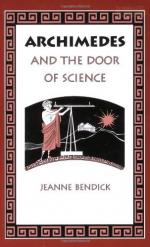|
This section contains 453 words (approx. 2 pages at 400 words per page) |

|
Archimedes and the Door of Science Summary & Study Guide Description
Archimedes and the Door of Science Summary & Study Guide includes comprehensive information and analysis to help you understand the book. This study guide contains the following sections:
This detailed literature summary also contains Topics for Discussion and a Free Quiz on Archimedes and the Door of Science by Jeanne Bendick.
Archimedes and the Door of Science is a book written for primary school students on the life and discoveries of the great Greek mathematician and scientist Archimedes of Syracuse. The author encourages home educators to use the book and suggests that it can be used as part of a history, science or mathematics curriculum. It contains various examples of how to construct an experiment to illustrate one of Archimedes's discoveries and contains helpful illustrates for the student reader.
The book contains fourteen chapters. In Chapter 1, Who Was Archimedes, the author introduces the reader to Archimedes, a citizen of Greece who was born in Syracuse on the island of Sicily south of Italy in 287 B.C. His father was an astronomer and he had an elite education growing up. His mind constantly raced and he was always fascinated by technical problems. He is one of the giants of science and mathematics. He invented the sciences of mechanics, hydrostatics and prefigured important work in calculus, geometry, number theory, chemistry, and astronomy.
Chapter 2, The World of Archimedes, describes the historical setting for Archimedes's life and work, which involves explaining the culture of Syracuse and Greek culture generally, along with Archimedes education, surrounding geography and the extent of the known world. The author talks about the unique Greek approach to knowledge and their love of argument and abstract thought. We also learn that Archimedes was related to the King of Syracuse, a relationship that proves important later on.
In Chapter 3, Alexandria!, Archimedes also studied in Alexandria at the great library and museum there with many other important mathematicians and scientists. We also learn about Archimedes famous irrigation tool, the Archimedean Screw and we learn about his use of simple machines generally. Chapter 4, Archimedes and His Lever, discusses Archimedes famous use of levers, and his claim that he could move the world if he had a lever long enough. Chapter 5, Archimedes and King Hiero's Crown recounts the details of the famous 'Eureka!' story and Archimedes discovery of the idea of density. Chapter 6, Archimedes and Astronomy, Chapter 7, Archimedes and Mathematics, Chapter 8, The Measurement of a Circle and Chapter 9, Archimedes and Numbers discuss his contributions to astronomy, mathematics, circle measurement and numeration respectively. Chapter 10, Archimedes and Centers of Gravity discusses Archimedes's important insights into Centers of Gravity and Chapter 11, The Sphere and the Cylinder, discusses his favorite discovery and symbolic epitaph.
Chapter 12, The War Machines of Archimedes, discusses the war machines Archimedes built to defend Syracuse against Marcellus, the Roman General, and Chapter 13, The End of Archimedes discusses how Archimedes died at the hands of a Roman soldier three years after the siege of Syracuse began. Chapter 14, No End to Archimedes, recaps his everlasting discoveries.
Read more from the Study Guide
|
This section contains 453 words (approx. 2 pages at 400 words per page) |

|



